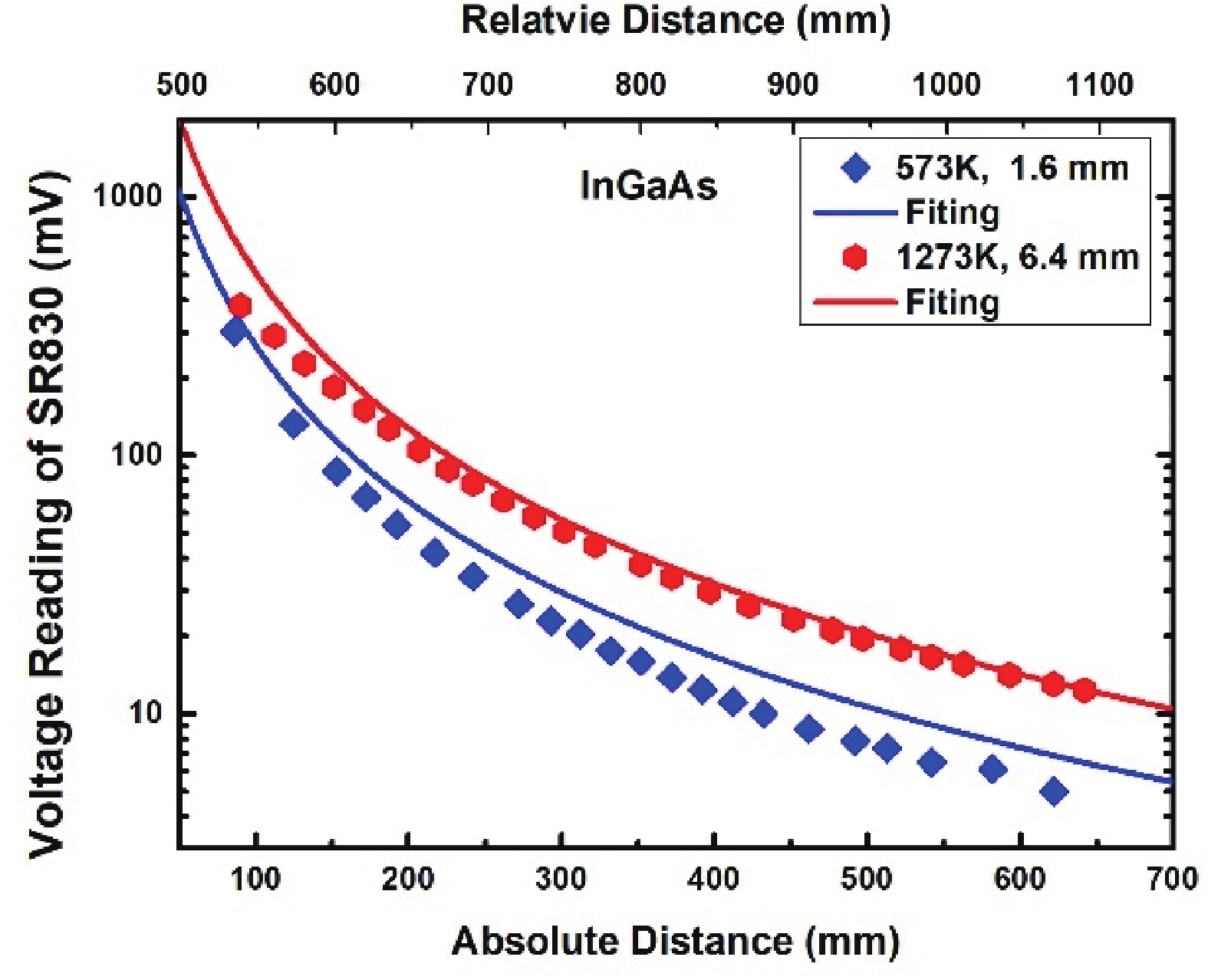| Citation: |
Nong Li, Dongwei Jiang, Guowei Wang, Weiqiang Chen, Wenguang Zhou, Junkai Jiang, Faran Chang, Hongyue Hao, Donghai Wu, Yingqiang Xu, Guiying Shen, Hui Xie, Jingming Liu, Youwen Zhao, Fenghua Wang, Zhichuan Niu. The measurement of responsivity of infrared photodetectors using a cavity blackbody[J]. Journal of Semiconductors, 2023, 44(10): 102301. doi: 10.1088/1674-4926/44/10/102301
****
N Li, D W Jiang, G W Wang, W Q Chen, W G Zhou, J K Jiang, F R Chang, H Y Hao, D H Wu, Y Q Xu, G Y Shen, H Xie, J M Liu, Y W Zhao, F H Wang, Z C Niu. The measurement of responsivity of infrared photodetectors using a cavity blackbody[J]. J. Semicond, 2023, 44(10): 102301. doi: 10.1088/1674-4926/44/10/102301
|
The measurement of responsivity of infrared photodetectors using a cavity blackbody
DOI: 10.1088/1674-4926/44/10/102301
More Information
-
Abstract
For the measurement of responsivity of an infrared photodetector, the most-used radiation source is a blackbody. In such a measurement system, distance between the blackbody, the photodetector and the aperture diameter are two parameters that contribute most measurement errors. In this work, we describe the configuration of our responsivity measurement system in great detail and present a method to calibrate the distance and aperture diameter. The core of this calibration method is to transfer direct measurements of these two parameters into an extraction procedure by fitting the experiment data to the calculated results. The calibration method is proved experimentally with a commercially extended InGaAs detector at a wide range of blackbody temperature, aperture diameter and distance. Then proof procedures are further extended into a detector fabricated in our laboratory and consistent results were obtained. -
References
[1] Clark Jones R. ‘Detectivity’: The reciprocal of noise equivalent input of radiation. Nature, 1952, 170, 937 doi: 10.1038/170937b0[2] Clark Jones R. Phenomenological description of the response and detecting ability of radiation detectors. Proc IRE, 1959, 47, 1495 doi: 10.1109/JRPROC.1959.287047[3] Aifer E H, Tischler J G, Warner J H, et al. W-structured type-II superlattice long-wave infrared photodiodes with high quantum efficiency. Appl Phys Lett, 2006, 89, 053519 doi: 10.1063/1.2335509[4] Nguyen B M, Hoffman D, Wei Y J, et al. Very high quantum efficiency in type-II InAs/GaSb superlattice photodiode with cutoff of 12μm. Appl Phys Lett, 2007, 90, 231108 doi: 10.1063/1.2746943[5] Shafir I, Snapi N, Cohen-Elias D, et al. High responsivity InGaAsSb p–n photodetector for extended SWIR detection. Appl Phys Lett, 2021, 118, 063503 doi: 10.1063/5.0037192[6] Li N, Chen W Q, Zheng D N, et al. The investigations to eliminate the bias dependency of quantum efficiency of InGaAsSb nBn photodetectors for extended short wavelength infrared detection. Infrared Phys Technol, 2020, 111, 103461 doi: 10.1016/j.infrared.2020.103461[7] Wang C A, Choi H K, Ransom S L, et al. High-quantum-efficiency 0.5 eV GaInAsSb/GaSb thermophotovoltaic devices. Appl Phys Lett, 1999, 75, 1305 doi: 10.1063/1.124676[8] Cohen-Elias D, Snapi N, Klin O, et al. Minority carrier diffusion length for electrons in an extended SWIR InAs/AlSb type-II superlattice photodiode. Appl Phys Lett, 2017, 111, 201106 doi: 10.1063/1.5005097[9] Charache G W, Baldasaro P F, Danielson L R, et al. InGaAsSb thermophotovoltaic diode: Physics evaluation. J Appl Phys, 1999, 85, 2247 doi: 10.1063/1.369533[10] Hoffman D, Nguyen B M, Delaunay P Y, et al. Beryllium compensation doping of InAs/GaSb infrared superlattice photodiodes. Appl Phys Lett, 2007, 91, 143507 doi: 10.1063/1.2795086[11] Ting D Z Y, Hill C J, Soibel A, et al. A high-performance long wavelength superlattice complementary barrier infrared detector. Appl Phys Lett, 2009, 95, 023508 doi: 10.1063/1.3177333[12] Rehm R, Walther M, Schmitz J, et al. InAs/GaSb superlattices for advanced infrared focal plane arrays. Infrared Phys Technol, 2009, 52, 344 doi: 10.1016/j.infrared.2009.09.005[13] Kim H S, Plis E, Rodriguez J B, et al. Mid-IR focal plane array based on type-II InAs/GaSb strain layer superlattice detector with nBn design. Appl Phys Lett, 2008, 92, 183502 doi: 10.1063/1.2920764[14] Prineas J P, Yager J, Seyedmohamadi S, et al. Leakage mechanisms and potential performance of molecular-beam epitaxially grown GaInAsSb 2.4 μm photodiode detectors. J Appl Phys, 2008, 103, 104511 doi: 10.1063/1.2932080[15] Shao H, Torfi A, Li W, et al. High detectivity AlGaAsSb/InGaAsSb photodetectors grown by molecular beam epitaxy with cutoff wavelength up to 2.6μm. J Cryst Growth, 2009, 311, 1893 doi: 10.1016/j.jcrysgro.2008.12.009[16] Vincent J D, Hodges S, Vampola J, et al. Fundamentals of infrared and visible detector operation and testing. John Wiley & Sons, 2015[17] Li N, Sun J, Jia Q X, et al. High performance nBn detectors based on InGaAsSb bulk materials for short wavelength infrared detection. AIP Adv, 2019, 9, 105106 doi: 10.1063/1.5124093 -
Proportional views






 DownLoad:
DownLoad:














 Nong Li:got his bachelor’s degree in 2017 from the University of Electronic Science and Technology of China and his master’s degree in 2020 from the University of Chinese Academy of Sciences. He is currently doing his PhD program at the University of Chinese Academy of Sciences under the supervision of Prof. Zhichuan Niu. His research focuses on the design, material growth, fabrication and characterization of infrared photodetectors
Nong Li:got his bachelor’s degree in 2017 from the University of Electronic Science and Technology of China and his master’s degree in 2020 from the University of Chinese Academy of Sciences. He is currently doing his PhD program at the University of Chinese Academy of Sciences under the supervision of Prof. Zhichuan Niu. His research focuses on the design, material growth, fabrication and characterization of infrared photodetectors Dongwei Jiang:graduated with a PhD from Harbin Institute of Technology in 2016. He is a postdoctoral fellow at the Institute of Semiconductors, Chinese Academy of Sciences and is currently serving as an associate researcher. He has been conducting research on antimonide superlattice infrared detectors and is proficient in detector theoretical structure design, material epitaxy, and device fabrication
Dongwei Jiang:graduated with a PhD from Harbin Institute of Technology in 2016. He is a postdoctoral fellow at the Institute of Semiconductors, Chinese Academy of Sciences and is currently serving as an associate researcher. He has been conducting research on antimonide superlattice infrared detectors and is proficient in detector theoretical structure design, material epitaxy, and device fabrication Zhichuan Niu:is a researcher at the Institute of Semiconductors, Chinese Academy of Sciences, Chief Professor of Quantum Optoelectronics at the College of Material Science and Optoelectronics of the University of Chinese Academy of Sciences. His main research fields are compound semiconductor materials and quantum optoelectronic devices, semiconductor quantum dot quantum light source devices, near-infrared communication band quantum dot/quantum well lasers, and arsenic and antimony compound semiconductor optoelectronic devices
Zhichuan Niu:is a researcher at the Institute of Semiconductors, Chinese Academy of Sciences, Chief Professor of Quantum Optoelectronics at the College of Material Science and Optoelectronics of the University of Chinese Academy of Sciences. His main research fields are compound semiconductor materials and quantum optoelectronic devices, semiconductor quantum dot quantum light source devices, near-infrared communication band quantum dot/quantum well lasers, and arsenic and antimony compound semiconductor optoelectronic devices



